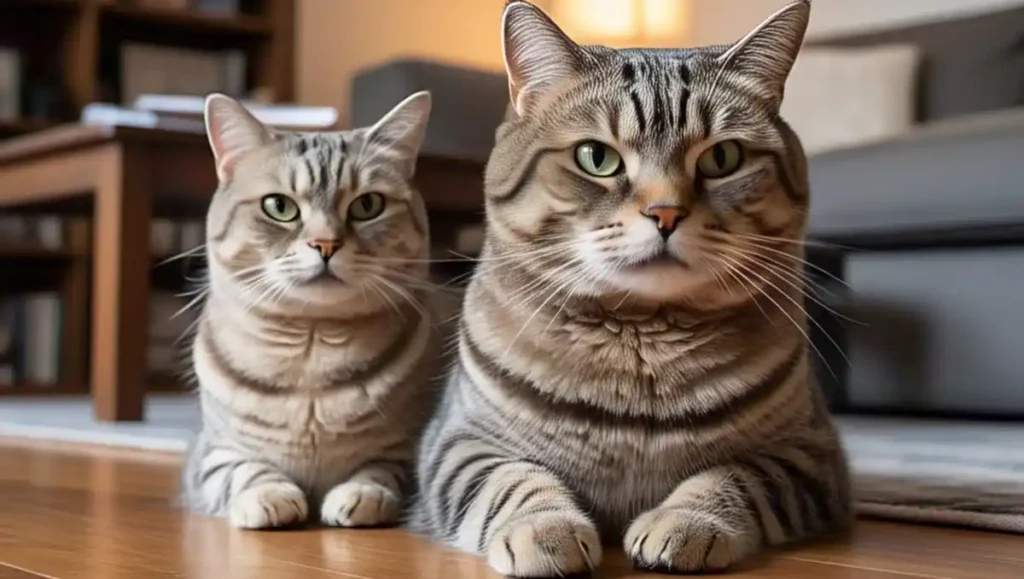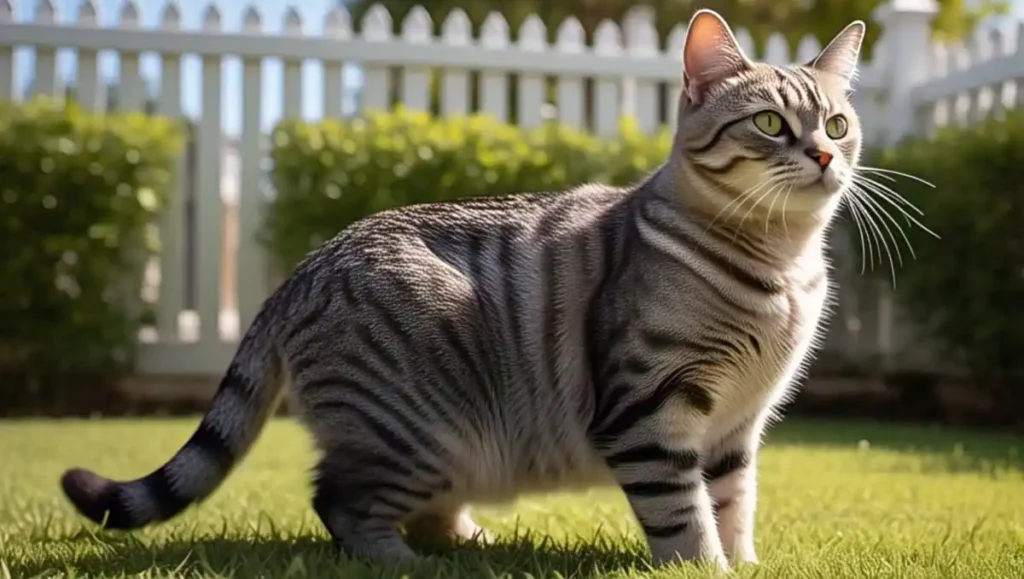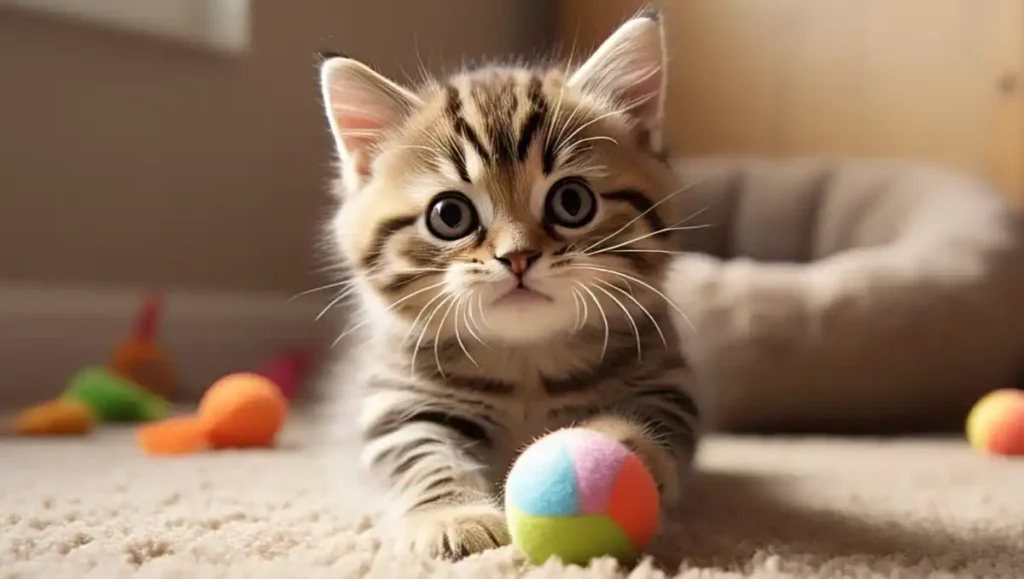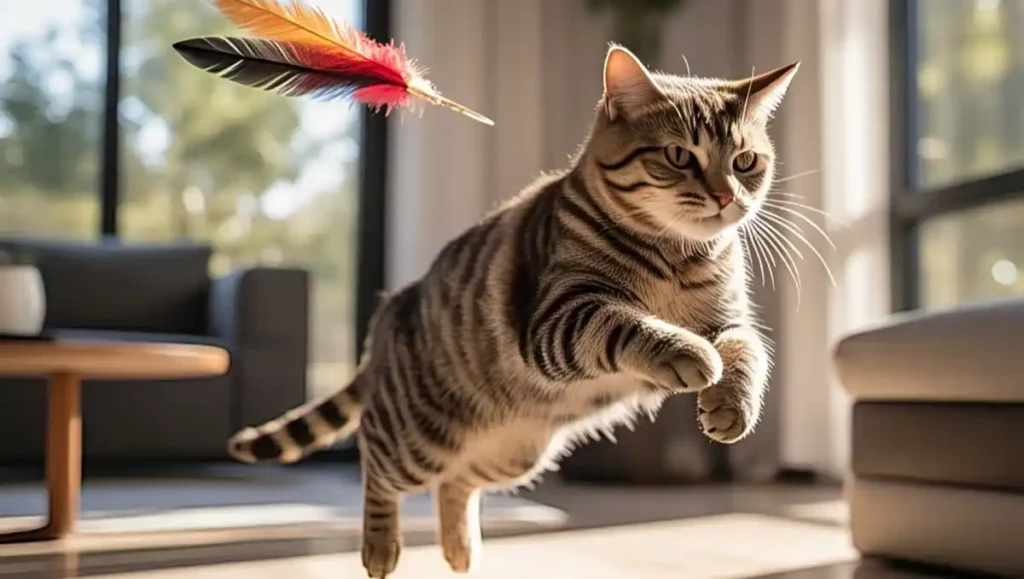How Big Does an American Shorthair Cat Get?
An American Shorthair cat typically grows to a medium to large size, with males weighing between 11 and 15 pounds and females between 8 and 12 pounds.
They usually reach their full size around 3 to 4 years of age.
- Size: Males 11-15 lbs, females 8-12 lbs. Full size by 3-4 years.
- Appearance: Muscular, balanced build, square muzzle, thick coat.
- Growth: Slow, influenced by genetics, diet, and activity.
- History: Bred for rodent control, recognized in 1906, renamed in 1966.
- Development: Rapid kitten growth, slow maturity by 3-4 years.
- Health: Proper diet, exercise, and vet check-ups support growth.
- Physical Traits: Medium to large, muscular, almond eyes, easy-care coat.
American Shorthair cats are known for their sturdy build and balanced proportions.
Their height ranges from 8 to 10 inches (20 to 25 cm), and their body length can stretch between 12 and 15 inches (30 to 38 cm).
At different stages, their weight changes.
For example, at 3 months, they may weigh 2 to 4 pounds, and by 1 year, they can reach 6 to 9 pounds.
Growth depends on age, diet, and activity levels.
Males tend to be heavier, while females stay slightly smaller.
It’s helpful to keep a simple chart to track your kitten’s progress as they grow.
Though every cat is unique, most American Shorthairs fit into the 6–15 pounds range by adulthood.
They are a perfect pet for families, children, seniors, and even other cats or dogs.
With a long lifespan of 15 to 20 years, they grow slowly and steadily into strong, loving companions.
Overview of the American Shorthair Cat
What is an American Shorthair?
An American Shorthair is a smart, playful, and sturdy domestic cat breed known for its hunting skills and friendly nature, making it a perfect family companion.

The American Shorthair is a moderately active, smart cat with a long and proud history.
This feline comes from European cats brought to North America by settlers.
They helped protect cargo and food stores from rodents, mice, and rats.
These early cats were known as working cats, and that strong spirit is still part of the breed today.
This pedigreed cat became one of the top breeds in 2020, according to the Cat Fanciers’ Association.
The American Shorthair is rugged, self-sufficient, and full of life.
She enjoys playing with interactive toys, solving puzzles, and using her intelligence to learn new tricks.
She may even try to supervise your household with curiosity and charm!
With a sturdy body, strong hunting instinct, and loving heart, the American Shorthair is the kind of companion that fits right into any home.
Whether chasing insects or relaxing with the family, she’s a truly special family cat.
History and Breed Background
The American Shorthair breed has a rich history, originating with early European settlers who brought cats to North America for rodent control.
These cats, first known as Domestic Shorthairs, became the foundation of the breed.
The Cat Fanciers’ Association (CFA) officially recognized them as a breed in 1906, and in 1966, the name was changed to American Shorthair to honor its American origins.
History and Development of the American Shorthair
The American Shorthair breed traces its roots to European cats that arrived with the settlers on ships to North America.
These cats played an important role in rodent control during the early days of settlements.
Over time, they adapted to the local environment, becoming a strong and reliable breed.
The name Domestic Shorthair was used initially, and they were recognized as a breed by the CFA in 1906.
Later, the breed was renamed to American Shorthair in 1966 to highlight its heritage and distinguish it from other shorthair breeds.
Early Recognition and Contribution
The American Shorthair was widely respected and often exhibited at early cat shows, where they were admired by cat fanciers.
In 1896, a brown tabby from the breed fetched a significant price at the second annual cat show.
The breed was one of the first to be formally recognized by the CFA, and by 1906, it was registered as one of the first five breeds.
Its important role in rodent control continued to be a key characteristic of the breed, even as it became more refined and popular.
The Breed’s Evolution
As the American Shorthair continued to thrive, selective breeding helped enhance its desirable traits, making it a beloved companion cat.
The breed was carefully developed to match specific conformation standards, which were set by cat fanciers and organizations like the International Cat Association (TICA) and CFA.
Today, the American Shorthair is a proud, pedigreed breed accepted by all major North American registries.
General Appearance and Build
The American Shorthair is a muscular, sturdy cat with a balanced and robust build.
It is medium-sized, with some cats growing to large-sized proportions.
Known for its strength and agility, the breed has a distinctive appearance, marked by a powerful jaw, full cheeks, and a square muzzle.
Their short coat is thick and easy to care for, providing great insulation in various conditions.
The head of the American Shorthair is slightly longer with medium-sized, rounded ears that sit well on the cat’s head.
The eyes are almond-shaped with a beautiful green or gold color, giving the cat a striking eye shape.
Their dense coat comes in a wide range of colors and patterns, including silver tabbies and brown tabby.
Males typically weigh between 11-15 lbs, while females are around 6-12 lbs.
The American Shorthair has a muscular body that reflects its strength and agility.

The hard-textured coat makes it well-suited to thrive in various environments, including rough weather or bushes and brambles.
This breed is also known for its good insulation, keeping it comfortable through changes in temperature.
Their wide-set eyes, full cheeks, and square muzzle give them a distinctive and appealing face.
The thick coat is easy to care for, and it sheds a moderate amount, ensuring minimal maintenance for owners.
You’ll find American Shorthairs in a variety of colors and patterns, such as the popular silver tabbies and brown classic tabbies.
These cats reach their mature size by about 3 or 4 years, showcasing their fairly large stature at full growth.
The American Shorthair is not just a pretty face; it’s a muscular and agile cat with a strong, robust build.
Their distinctive eye shape and square muzzle add to their striking appearance, making them a wonderful pet for any family.
Average Size of an American Shorthair
Male American Shorthair Size
Males tend to be larger and heavier, weighing between 11 to 15 pounds.
Their body length measures 12 to 15 inches, with an overall height of around 8 to 10 inches.
These cats are often seen as medium to large-sized and are admired for their sturdy, well-proportioned bodies.
Female American Shorthair Size
Females are typically lighter, ranging from 8 to 12 pounds.
Their body length is about 12 to 15 inches, and their overall height is around 8 to 10 inches.
Despite being smaller than males, they still retain a well-balanced and strong stature, known for their muscular build and proportionate size.
Length from Nose to Tail
The average American Shorthair measures 12-15 inches (30-38 cm) from the nose to the base of the tail, not including the tail itself.
Most American Shorthair cats have a strong, balanced body.
Their size may vary depending on if they are males or females.
Males are usually heavier, weighing 11-15 lbs, while females weigh around 6-12 lbs.
They are known as a medium to large breed.
Their head is oblong, with more length than width.
The ears are medium sized with rounded tips, and the eyes are large and wide.
The neck and legs are of medium length, and both are muscular and well-muscled.
The tail also has a medium length, adding to the cat’s elegant shape.
Growth Stages Explained
American Shorthairs grow slowly and steadily, reaching their full size between 3 to 4 years.
Their growth has clear stages, starting from kittenhood, moving through adolescence, and finally into adulthood and senior years.
Kitten Stage (0–6 months)
The kitten stage in American Shorthairs (0–6 months) is a rapid development phase.
During this time, they grow fast, begin solid food, build immunity, and need high energy and proper nutrition for healthy growth.
The kitten stage of an American Shorthair is full of change and excitement.
At birth, they are tiny and soft. By 3 weeks, they begin eating solid food along with milk.
At 6 weeks, their immune system starts to strengthen with help from colostrum, as noted by Royal Canin.
This time is often called the construction phase.
Their body and brain grow quickly. They need a special kitten diet rich in nutrients.

This supports healthy weight, strength, and overall development.
Feeding the right food in correct amounts ensures your kitten grows strong and stays active.
Adolescent Stage (6 months – 1 year)
From 7 months onward, they enter adolescence.
Growth slows down, but the body continues to build muscle mass and musculature.
I noticed males growing larger than females, which is common in the breed.
This is when they begin to look more mature and playful in new ways.
They continue to improve both physically and mentally.
Adult Stage (1 – 5 years)
Between 1-2 years, growth continues slowly.
By 3-4 years, most American Shorthairs reach their full size.
This shows their slow maturity, which is normal and healthy.
Their physical maturity and strong bodies are easy to see.
Purina US confirms that this is the time when their body size becomes stable.
Keeping an eye on their weight, giving balanced calories, and good weight management helps them stay active and happy.
Senior Stage (5+ years)
By 5 years and beyond, American Shorthairs enter their senior years.
While growth stops, they enjoy a slower pace of life.
Gentle exercise, good care, and proper diet help them stay fit. At 10+ years, they still show love and calm energy.
With continued nutrition and attention, they live well and bring joy at every stage.
When Do American Shorthairs Stop Growing?
American Shorthair cats typically stop growing between 3 years and 4 years of age.
They may continue to grow slowly during this time, but their full size is usually reached by this age.
Slow Growth and Maturity
American Shorthair cats have a unique growth pattern.
Unlike many other cats, they grow more slowly.
While most cats reach their full size around 12 months to 18 months, American Shorthairs take a bit longer, reaching their full adult size around 3 or 4 years.
Their physical maturity and musculature also continue to develop during this time.
Factors Affecting Growth
Growth in American Shorthairs can vary due to factors like genetics, diet, and health.
Males often reach full size later than females and tend to be larger.
Although their growth is slower, they still reach a healthy, full size by 3-4 years.
During the first year, the cat’s growth is the fastest, and after that, it’s important to monitor their weight gain to ensure they stay at a healthy weight.
The growth rate and development of each American Shorthair can differ, so it’s normal to see some variation in size among individual cats.
Factors That Influence Their Size
The size of an American Shorthair is influenced by genetics, diet, and exercise.
Male cats are generally larger than female cats.
A high-quality diet, the right portions, and regular exercise help maintain a healthy weight and support growth.
Genetics and the environment also play important roles in determining their adult size.
The size of an American Shorthair is shaped by several factors.
Genetics play a big part, with male cats typically being larger than female cats.
The size of the parents can influence the size of the kittens.
Diet is another key factor—feeding them a high-quality diet and the right portions ensures they grow healthy and strong.
Overfeeding can lead to unnecessary weight gain, so it’s essential to feed your cat in moderation.
In addition, exercise is crucial for maintaining a healthy weight and supporting proper growth.
Neutered cats may need extra attention when it comes to exercise, as they can be more prone to gaining weight.
Keeping your cat active helps prevent any health issues and supports a healthy adult size.
If you’re unsure about your cat’s size or growth, it’s always a good idea to consult a veterinarian.
They can offer advice on the right diet, portions, and exercise plan to help your cat stay in great health.
How to Tell if Your American Shorthair is Overweight or Underweight?
To determine if your American Shorthair is overweight or underweight, look at their body condition from different angles.
A visual assessment helps, such as checking the waistline, ribcage, and hips.
You should also gently feel their ribs through a thin layer of fat.
Regular checkups with your vet can help ensure your cat is at their ideal weight.
For a more detailed assessment, you can use both visual and tactile methods.
Look at your cat from above to see if they have a noticeable waistline or tuck between the ribcage and hips.
A rounded belly or fat pad that hangs down may show that your cat has extra weight.
When you feel their ribs, you should be able to touch them easily with a light amount of fat covering them.
If you need to press through more fat, your cat might need to adjust their diet and exercise.
For an accurate assessment, your vet can perform a body condition score (BCS), which is a helpful tool for determining your cat’s ideal weight based on their breed and body structure.
If you find that your American Shorthair appears thin, you may see their ribs or spine clearly.
A tucked abdomen might indicate that they are underweight.
Nutrition and a vet’s recommendations can help your cat regain a healthy weight.
Keep in mind that factors like individual variation and breed standards can influence your cat’s weight, as some breeds are naturally heavier or lighter.
Regular vet visits will ensure your cat stays in the best shape possible.
Tips to Support Healthy Growth
To support the healthy growth of your American Shorthair, focus on providing proper nutrition, exercise, and regular veterinary check-ups.
A balanced diet and a clean, stimulating environment play key roles in their development.
Nutrition and Hydration
Provide kitten-specific food for young cats, ensuring they get the energy, protein, and other nutritional needs they require.
Once they grow older, switch to adult food that meets their needs for body maintenance and growth.
Always ensure access to fresh water to prevent dehydration and support urinary regularity.
Play, Exercise, and Enrichment
Encourage daily play to promote physical activity and mental stimulation.

Offer toys that align with their hunting instincts and ensure they have enough vertical space and scratching posts to stay active and healthy.
A clean and stimulating environment will further enhance their growth and happiness.
Regular Check-Ups and Grooming
Schedule regular check-ups with your veterinarian to monitor your cat’s overall health.
Regular dental care, including teeth brushing and professional dental cleanings, helps maintain their well-being.
Keep up with brushing to reduce loose hair and avoid hairballs, and don’t forget to trim their nails regularly.
Frequently Asked Questions
At what age is an American Shorthair cat full grown?
An American Shorthair cat reaches full size between 3 and 4 years old. They grow slowly but steadily. Males usually get bigger than females. Regular feeding and play help them grow strong.
Are American Shorthair cats cuddly?
Yes, American Shorthair cats can be cuddly. They enjoy spending time with people and love being around family. They are gentle, calm, and like attention without being too clingy.
What are the cons of the American Shorthair?
The American Shorthair needs regular play and care to stay healthy. Their thick coat sheds, so brushing helps. They grow slowly, so you’ll need to be patient while they mature.
Are American Shorthair cats rare?
No, American Shorthair cats are not rare. They are a popular and well-known breed in the U.S. They are easy to find through breeders and shelters.
Conclusion
American Shorthairs grow at their own pace—slow and steady.
With love, good food, and play, they blossom into strong, happy companions.
Whether male or female, kitten or senior, these cats fit right into family life with their balanced size and sweet nature.
Disclaimer
The content on this blog is for informational purposes only. As a pet expert and writer for Catohouse.com, I share knowledge based on experience and research. Always consult a licensed veterinarian for professional advice regarding your pet’s health and care.

